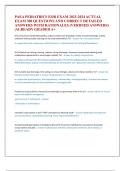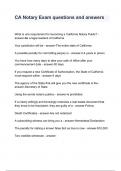PAEA PEDIATRICS EOR EXAM 2023-2024 ACTUAL
EXAM 300 QUESTIONS AND CORRECT DETAILED
ANSWERS WITH RATIONALES (VERIFIED ANSWERS)
|ALREADY GRADED A+
Dx? preauricular lymphadenopathy, copious watery eye discharge, scanty mucoid discharge, usually
unilateral with punctate staining on slit lamp examination; Tx? - answer-dx: viral conjunctivitis
tx: supportive (cool compresses, artificial tears) +/- antihistamines for itching (Olopatadine)
Dx? bilateral eye itching, tearing, redness, string discharge, chemosis (conjunctival swelling) with
cobblestone appearance to inner/upper eyelids; Tx? - answer-dx: allergic conjunctivitis
tx: topical antihistamines (H1 blockers) (Olopatadine, Pheniramine/Naphazoline, Emedastine), topical
NSAID (ketorolac), topical corticosteroids (but s/e of long term use = glaucoma, cataracts, HSV keratitis)
Dx? purulent eye discharge, lid crusting, no visual changes, absence of ciliary injection; Tx? - answer-dx:
bacterial conjunctivitis (MC S. aureus, Strep pneumo, H. influenzae)
tx: topical abx (erythromycin, fluoroquinolones, sulfonamides, aminoglycosides); if contact lens wearer
cover for pseudomonas w/ fluoroquinolone or aminoglycoside
if bacterial conjunctivitis is found to be chlamydia or gonorrhea what is the tx? - answer-admit for IV and
topical abx (ophtho emergency)
-gonoccoccal: IV ceftriaxone + topical
-chlamydia: IV azithromycin
neonatal conjunctivitis is aka? if left untreated can develop what? - answer-ophthalmia neonatorum;
corneal ulceration, opacification/scarring, visual impairment/blindness
standard prophylaxis given immediately after birth to prevent ophthalmia neonatorum (neonatal
conjunctivitis) includes: - answer-erythromycin ointment, tetracycline ointment, silver nitrate, or
povidone-iodine
,if ophthalmia neonatorum (neonatal conjunctivitis) develops on day 1 after birth what is the most likely
cause? day 2-5? day 5-7? day 7-11? - answer-day 1: silver nitrate (chemical cause- prophylaxis is what
can cause the condition)
day 2-5: gonococcal
day 5-7: chlamydia
day 7-11: HSV
orbital (septal) cellulitis is usually secondary to _________ infection in most commonly what age group?
- answer-sinus; 7-12y; other causes include dental/facial infxns or bacteremia
what is the most common sinus infection (90%) that causes secondary orbital cellulitis? what organisms
are the cause? - answer-ethmoid; S. aureus, Strep. pneumo, GABHS (Strep. pyogenes), H. influenzae
work up/Dx? decreased vision, pain w/ ocular movement, proptosis (bulging eye), eyelid erythema and
edema; tx? - answer-dx: orbital cellulitis
work up: CT scan (showing infxn of fat & ocular muscles) or MRI
tx: IV antibiotics (Vanc, Clinda, Cefotaxime, Ampicillin/Sulbactam)
what is the difference b/t orbital (septal) cellulitis and preseptal cellulitis? - answer-preseptal may still
have ocular pain, redness and swelling but NO visual changes or pain w/ ocular mvmt (hasn't affected
the muscles)
misalignment of the eyes is aka? when does stable ocular alignment present in infants? - answer-
strabismus; 2-3 mos
convergent strabismus is aka? divergent strabismus is aka? - answer-convergent: esotropia (deviated
inward "cross eyed")
divergent: exotropia (deviated ouward)
a + Hirschberg corneal light reflex test, diplopia, scotomas (blind spots), or amblyopia (lazy eye) are
clinical manifestations of what condition? what other tests can be performed? - answer-strabismus;
cover-uncover test to determine the angle of strabismus, cover test, convergence testing
,how can strabismus be treated? - answer--patch therapy: normal eye is covered to stimulate and
strengthen the affected eye
-eyeglasses
-corrective therapy: if severe or unresponsive to conservative therapy
if not treated before 2 y/o, amblyopia may occur and cause decreased visual acuity that is not
correctable
Dx? 1-2 days of ear pain, pruritis in the ear canal, auricular discharge, pressure/fullness, hearing usually
preserved, pain with tug test and tragus pressure, auditory canal erythema/edema/debris, recent
swimming pool use; MC organisms? Tx? - answer-Dx: otitis externa
MC organisms: *pseudomonas*, proteus, s. aureus, s. epidermis, GABHS, anaerobes
(peptostreptococcus), aspergillus
Tx: 1. protect ear against moisture (isopropyl alcohol and acetic acid) 2. ciprofloxacin/dexamethasone
(ofloxacin safe if there is an associated TM perf) 3. Aminoglycoside combo (neomycin/polytrim-
B/hydrocortisone -BUT not used if perf suspected bc ototoxic 4. amphotericin B if fungal
malignant otitis externa is osteomyelitis at the skull base secondary to ___________ infxn; MC seen in
what pt populations; Tx? - answer-pseudomonas; MC in DM and immunocompromised pts; Tx w/ IV
Ceftazidime or Piperacillin + FQ or Aminoglycoside
acute otitis media is an infection of the middle ear, temporal bone and mastoid air cells that is MC
preceded by - answer-a viral URI that causes edema of eustachian tube, negative pressure, transudation
of fluid and mucus in middle ear that allows for bacterial growth
what are the 4 MC organisms seen in acute otitis media? - answer-*Strep pneumo*, H. influenza,
Moraxella catarrhalis, Strep pyogenes (same as seen in acute sinusitis)
Dx: fever, otalgia, ear tugging in infants, conductive hearing loss, stuffiness, possible drainage from ear,
bulging/erythematous TM w/ effusion, dec TM mobility on pneumatic otoscopy; Tx? - answer-dx: acute
otitis media
tx: 1st line- amoxicillin, 2nd line- augmentin (amoxicillin-clavulate); if PCN allergy- azithromycin,
clarithromycin, erythromycin-sulfisoxazole, trimethoprim/sulfamethoxazole, if PCN adverse effect but
not allergy- ceftriaxone, cefdinir, cefixine
, don't forget to treat pain as well (ibuprofen or tylenol); can also perform myringotomy (surgical
drainage) to relieve pain
tympanostomy if recurrent >4 times in 1 yr
if bullae are seen on the TM of a pt with AOM what should you suspect? - answer-mycoplasma
pneumoniae
Dx? deep ear pain (worse at night), fever, mastoid tenderness and possibly fluctuance (abscess),
following AOM infxn; complications? - answer--dx: mastoiditis (inflammation of the mastoid air cells of
the temporal bone- mastoid and middle ear are connected)
-complications: hearing loss, labyrinthitis, vertigo, CN VII paralysis, brain abscess
how is mastoiditis diagnosed and treated? - answer-dx: by CT scan is 1st line test
tx: IV abx (same as w/ AOM- amoxicillin 1st line, augmentin 2nd line, azithromycin for allergy to PCN,
ceftriaxone for ADR to PCN) + middle ear/mastoid drainage (myringotomy +/- tympanostomy tube
placement- can obtain Cx)
if mastoiditis refractory to tx or complicated = mastoidectomy
what are the 2 auditory examination tests (and what order do you perform them in)? - answer-1st
Weber (tuning fork placed on top of head)
2nd Rinne (tuning fork placed on mastoid bone by ear)
if a child has conductive hearing loss in their L ear what will the Weber and Rinne tests show? - answer-
Weber: lateralizes to L ear
Rinne: BC > AC
if a child has sensorineural hearing loss in the R ear what will the Weber and Rinne tests show? - answer-
Weber: lateralizes to L ear (the normal one)
Rinne: AC > BC (shows normal L ear)





